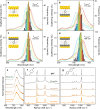Design rules for catalysis in single-particle plasmonic nanogap reactors with precisely aligned molecular monolayers
- PMID: 39455561
- PMCID: PMC11511967
- DOI: 10.1038/s41467-024-53544-3
Design rules for catalysis in single-particle plasmonic nanogap reactors with precisely aligned molecular monolayers
Abstract
Plasmonic nanostructures can both drive and interrogate light-driven catalytic reactions. Sensitive detection of reaction pathways is achieved by confining optical fields near the active surface. However, effective control of the reaction kinetics remains a challenge to utilize nanostructure constructs as efficient chemical reactors. Here we present a nanoreactor construct exhibiting high catalytic and optical efficiencies, based on a nanoparticle-on-mirror (NPoM) platform. We observe and track pathways of the Pd-catalysed C-C coupling reaction of molecules within a set of nanogaps presenting different chemical surfaces. Atomic monolayer coatings of Pd on the different Au facets enable tuning of the reaction kinetics of surface-bound molecules. Systematic analysis shows the catalytic efficiency of NPoM-based nanoreactors greatly improves on platforms based on aggregated nanoparticles. More importantly, we show Pd monolayers on the nanoparticle or on the mirror play significantly different roles in the surface reaction kinetics. Our data provides clear evidence for catalytic dependencies on molecular configuration in well-defined nanostructures. Such nanoreactor constructs therefore yield clearer design rules for plasmonic catalysis.
© 2024. The Author(s).
Conflict of interest statement
The authors declare no competing interest.
Figures





Similar articles
-
Plasmonic Nanogap-Enhanced Raman Scattering with Nanoparticles.Acc Chem Res. 2016 Dec 20;49(12):2746-2755. doi: 10.1021/acs.accounts.6b00409. Epub 2016 Nov 8. Acc Chem Res. 2016. PMID: 27993009
-
Catalytic and photocatalytic transformations on metal nanoparticles with targeted geometric and plasmonic properties.Acc Chem Res. 2013 Aug 20;46(8):1890-9. doi: 10.1021/ar3002393. Epub 2013 Jun 10. Acc Chem Res. 2013. PMID: 23750539 Review.
-
Synthesis and Raman Detection of 5-Amino-2-mercaptobenzimidazole Self-Assembled Monolayers in Nanoparticle-on-a-Mirror Plasmonic Cavity Driven by Dielectric Waveguides.Nano Lett. 2024 Mar 27;24(12):3670-3677. doi: 10.1021/acs.nanolett.3c04932. Epub 2024 Mar 14. Nano Lett. 2024. PMID: 38483128 Free PMC article.
-
Full Control of Plasmonic Nanocavities Using Gold Decahedra-on-Mirror Constructs with Monodisperse Facets.Adv Sci (Weinh). 2023 Apr;10(11):e2207178. doi: 10.1002/advs.202207178. Epub 2023 Feb 3. Adv Sci (Weinh). 2023. PMID: 36737852 Free PMC article.
-
Nanophotonic Platforms for Chiral Sensing and Separation.Acc Chem Res. 2020 Mar 17;53(3):588-598. doi: 10.1021/acs.accounts.9b00460. Epub 2020 Jan 8. Acc Chem Res. 2020. PMID: 31913015 Review.
Cited by
-
Requirements for fast multianalyte detection and characterisation via electrochemical-assisted SERS in a reusable and easily manufactured flow cell.Anal Bioanal Chem. 2025 Apr;417(9):1847-1861. doi: 10.1007/s00216-025-05763-w. Epub 2025 Feb 3. Anal Bioanal Chem. 2025. PMID: 39899114 Free PMC article.
-
Optomechanical Pumping of Collective Molecular Vibrations in Plasmonic Nanocavities.ACS Nano. 2025 Mar 25;19(11):10977-10988. doi: 10.1021/acsnano.4c16535. Epub 2025 Mar 14. ACS Nano. 2025. PMID: 40085022 Free PMC article.
References
-
- Nan, L. et al. Investigating plasmonic catalysis kinetics on hot-spot engineered nanoantennae. Nano Lett.23, 2883–2889 (2023). - PubMed
-
- Baumberg, J. J. Hot electron science in plasmonics and catalysis: what we argue about. Faraday Discuss.214, 501–511 (2019). - PubMed
-
- Zhou, L. et al. Quantifying hot carrier and thermal contributions in plasmonic photocatalysis. Science (1979)362, 69–72 (2018). - PubMed
-
- Jain, P. K. & El-Sayed, M. A. Plasmonic coupling in noble metal nanostructures. Chem. Phys. Lett.487, 153–164 (2010).
LinkOut - more resources
Full Text Sources

